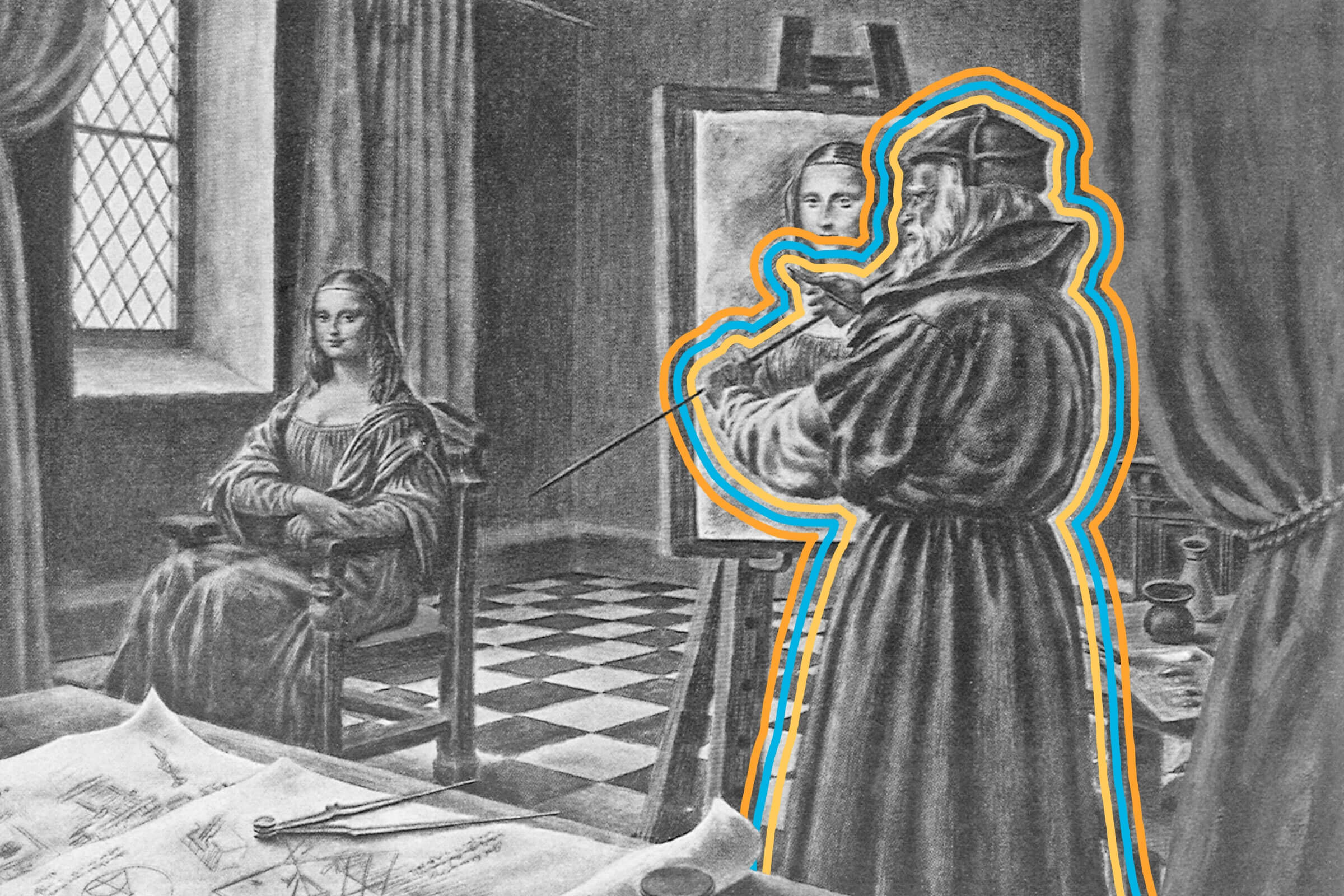

Whether in mathematics, anatomy, engineering, botany, cartography, or architecture, the 15th-century Florentine polymath Leonardo da Vinci had no equal. Oh, and he also found time to be one of the greatest artists who ever lived. Because his genius stretched into so many disciplines — and thousands of pages of his notes and sketches have survived the centuries — Leonardo remains one of history’s most well-known, yet still enigmatic, figures. Scientists and physicians still wonder how his brilliant mind worked, while engineers and designers marvel at (and in some cases construct) his many contraptions and inventions. These six facts explore the incredible life of the original Renaissance man.
“Da Vinci” Isn’t Leonardo’s Last Name

“Leonardo da Vinci” (pronounced starting with a “LAY”) is one of the most famous names in history — but it isn’t really the polymath’s name. Born in 1452 in Vinci, near the Italian city of Florence, Leonardo was the illegitimate son of wealthy notary Ser Piero da Vinci and a peasant woman named Catalina. Ser Piero acknowledged Leonardo as his son, and the nascent genius became known as Leonardo di ser Piero, meaning “son of Piero” (surnames were a relatively new phenomenon in Italy at the time and mostly reserved for the upper class). Because he had been born out of wedlock, Leonardo was — thankfully for us — given freedom to explore his intellectual pursuits, rather than be trained as a notary like his father, as was family custom at the time.
When Leonardo became an apprentice in his teenage years, he tacked on the moniker “da Vinci,” or “from Vinci,” to distinguish himself from the plethora of Leonardos in Florence and throughout Tuscany. That’s why, when referring to the famous figure, it’s more accurate to call him simply “Leonardo” rather than “da Vinci.” Who wants to tell Dan Brown the bad news?
Leonardo Designed the First Helicopter (and the First Tank)

Leonardo’s artistic legacy adorns the walls of museums (and one convent) around the world, and his works are visited by millions every year, but the famous Florentine’s scientific genius is also found in some 7,000 surviving pages of notes — each one detailing his thoughts on far-reaching ideas and concepts. One idea, known as the aerial screw, is considered to be the very first design of a vertical take-off and landing aircraft, also known as a helicopter. Another famous invention, Leonardo’s fighting vehicle, is essentially a 15th-century armored tank; it’d be nearly a half millennia before anything like these metal machines marched across European battlefields.
Leonardo’s surviving notebooks also contain various flying machines called ornithopters, history’s first conception of a parachute, and advanced ideas in zoology, mathematics, hydrology, anatomy, and geology. For example, almost four centuries before Charles Darwin, Leonardo theorized through the study of rocks and fossils that the Earth must be much older than the Bible had described. Without these notebooks, Leonardo might be remembered as a very good, even great (but not terribly prolific) Renaissance painter, but these yellowing pages reveal an astonishing mind working out mysteries that wouldn’t be solved for centuries.
He Created a Satellite Map… in 1502

Leonardo was a man ahead of his time, and nowhere is that more clear than in his “satellite” map of the Italian city of Imola. In August 1502, at the age of 50, Leonardo became general architect and engineer to Cesare Borgia, the son of Pope Alexander VI and a very wealthy individual. One of Leonardo’s chief missions was to survey Imola, a city near Bologna, in an effort to improve its fortifications. Unlike other maps of the time that were drawn from angled perspectives, filled with mythological or religious references, and/or more concerned with a town’s architectural beauty than cartographic accuracy, Leonardo’s map of Imola looks more at home on Google Maps than in a 16th-century atlas.
That’s because Leonardo created an ichnographic map, an idea first explored by the Roman architect Vitruvius (yes, that Vitruvius) in the first century BCE. It’s what we’d call a satellite map today, because the perspective of the map hovers directly above the city. Of course, Leonardo da Vinci didn’t have a satellite, so instead he likely paced the town by foot (perhaps using proto-odometer), using other tools such as a bussola (a tool that measures degrees inside a circle) to measure the degree of angles at every turn, and took bearings from the tower of the Palazzo Comunale. The result is an astonishingly accurate map, one that a 21st-century tourist could still use to navigate parts of Imola today.
He Was a Notorious Procrastinator

Leonardo da Vinci is the original “Renaissance man,” but his interest in, well, nearly everything also came with one big downside — he was a bit of a procrastinator. Compared to his artistic contemporaries, Leonardo didn’t produce nearly as many paintings, with only 20 or so — many of them still uncompleted — still around today. Instead, Leonardo was often distracted, and frequently caught doodling in his now-famous notebooks. Although Leonardo’s life is filled with remarkable accomplishments, it’s also littered with half-realized projects and unfinished masterpieces. One famous example is “The Virgin of the Rocks,” a painting that originally had a seven-month deadline, but took Leonardo 25 years to complete. Other works, such as the Sforza Horse — intended to be one of the world’s largest cast bronze statues — never saw the light of day despite years of work and planning.
His chronic perfectionism didn’t help, and Leonardo himself even lamented his lifelong inattention. According to his biographer and art historian Giorgio Vasari, Leonardo allegedly mentioned around the time of his death in 1519 “that he had offended God and mankind in not having worked at his art as he should have done.” Today, modern diagnoses of Leonardo’s behavior suggest he might have lived with attention deficit and hyperactivity disorder, or ADHD. Modern biographer Walter Isaacson argues that such a diagnosis could partly explain the creative engine behind Leonardo’s eclectic genius.
The “Mona Lisa” Remains Unfinished

The most well-known painting in the world is Leonardo da Vinci’s “Mona Lisa.” Around 10 million people glimpse the beguiling smile of Madam Lisa del Giocondo every year, but few of them likely know that the painting is actually unfinished. Although Leonardo began working on the painting in 1503, evidence suggests he was still refining the portrait around the year 1516. However, an illness in 1517 (possibly a stroke) caused semi-paralysis on the right side of his body, including his hand. Although he wrote with his left hand, Leonardo painted with his right, and this affliction likely caused the “Mona Lisa” to be left unfinished — at least in the artist’s eyes.
Keen-eyed art enthusiasts might point to the subject’s lack of eyebrows as evidence of the masterwork’s incomplete status, but some experts now believe the painting originally featured eyebrows and eyelashes that have been lost over time due to poor restoration.
Leonardo da Vinci Had an Intense Rivalry With Michelangelo

When it comes to Renaissance art, no two names are bigger than Leonardo and Michelangelo. Although considered two different generations of artists, Leonardo being Michelangelo’s senior by about 23 years, the duo had an intense rivalry reflected in both their art styles and general philosophy. Michelangelo’s hard lines, as seen in the Sistine Chapel, speak to his sculptural mindset, whereas Leonardo’s softer lines (also known as sfumato) and symmetrical composition attempted to capture nature in its mathematical beauty. However, their feud was also personal: One famous story recounts how Michelangelo gave Leonardo a dressing down in public by shaming him for the incomplete Sforza Horse. Returning the favor, Leonardo was the only artist to object to the full-frontal nudity of Michelangelo’s David. Considering Leonardo had an entire section in his notebook dedicated to the male member, it’s unlikely he was actually offended, but his argument won out, and David’s privates were covered with a garland of leaves serving as a loincloth.
